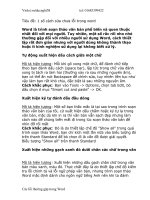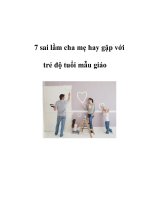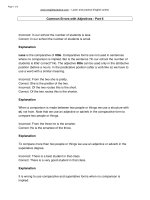LOI HAY GAP VOI GIOI TU 1. MR
Bạn đang xem bản rút gọn của tài liệu. Xem và tải ngay bản đầy đủ của tài liệu tại đây (22.8 KB, 3 trang )
Page 1 of 3
www.englishpractice.com – Learn and practice English online.
Common Errors in the Use of Prepositions
Knowing how to use prepositions correctly shows your mastery of the language.
This post is about the common errors in the use of prepositions.
Since and For
Since means ?from a point of time in the past'. It should be used with the present
perfect tense.
He has been ill since last week. (He fell ill two weeks ago and has been ill ever
since. He is still ill.)
It has been raining continuously since yesterday morning. (It is still raining.)
Don't use the simple present or present continuous tense with since. It is wrong to
say ?He is ill since last week' or ?It is raining since yesterday morning'.
For is used to refer to a period of time. It shows duration.
He has been ill for two weeks.
It has been raining for two days.
She has been sleeping for 10 hours.
Many ESL students commit the mistake of using since when referring to a period of
time.
He has been working for two hours. OR He has been working since 11 am. (NOT
He has been working since two hours.)
We have been living here for ten years. OR we have been living here since 1999.
(NOT We have been living here since ten years.)
Beside and Besides
ESL students often get confused about the meaning and use of these two words.
Note that beside means ?by the side of' and besides means ?in addition to'.
www.englishpractice.com – Learn and practice English online.
Page 2 of 3
She sat beside him. (= She sat by his side.)
Besides being a good writer, he is an excellent orator. (In addition to being a good
writer, he is an excellent orator.)
Between and Among
Between is used when the reference is to two people or things.
She stood between Alice and Peter.
You have to choose between these two options.
Among is used when the reference is to more than two people or things.
The British were able to conquer India because Indian princes quarreled among
themselves.
She sat among the children.
By and With
Use by when you want to refer to the doer of an action. Use with when you want to
refer to the instrument with which the action was performed.
The spider was killed by John. (John is the doer. He killed the spider.)
The spider was killed with a stone. (Stone is the instrument with which the spider
was killed.)
The spider was killed by John with a stone.
On, In and At
Use At with clock times.
I will meet you at 4 pm.
We had a party at 11 am.
Use on with days of the week and dates.
www.englishpractice.com – Learn and practice English online.
Page 3 of 3
We met on a Monday.
The meeting is on the 21st of this month.
Use in with morning, evening, afternoon, years, months and seasons.
She was born in October.
The postman brought this letter in the morning.
We visited Kashmir in the summer.
We bought this house in 2002.
Note that we use at with night.









